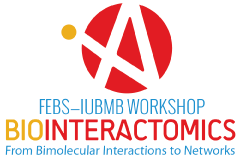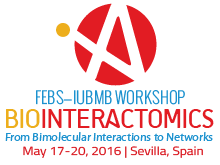For four days, from 17 to 20 May, the Isla de la Cartuja Scientific Research Centre (cicCartuja) will become a point of reference for Biointeractomics, a novel and supradisciplinary scientific field dedicated to the study of molecules from a broad perspective, by integrating approaches from Biology, Biochemistry, Engineering or Computer Science.
Under the motto “From biomolecular interactions to networks”, the FEBS-IUBMB Workshop on Biointeractomics aims to offer an overview of the links established between molecules in living organisms. The results of these studies could provide more details about the functioning of cells or the origin of various diseases. The FEBS-IUBMB Workshop on Biointeractomics will be attended by around twenty scientists from world-renowned centres such as King’s College London and Oxford University (United Kingdom), the Institute of Bioorganic Chemistry (Russia), the Centre for Magnetic Resonance Research (Italy), the National Cancer Research Centre (Madrid) and the Weizmann Institute (Israel).
Guest speakers include Robert Huber, a scientist at the Max Planck Institute of Biochemistry (Germany) and Honorary Professor at the University of Seville, who was awarded the Nobel Prize in Chemistry in 1988 for crystallising a protein essential to cyanobacterial photosynthesis and determining its structure using X-ray diffraction.
An interdisciplinary forum. The conferences will form the backbone of the FEBS-IUBMB Workshop on Biointeractomics, but they will not be the only activity included in the programme aimed at more than a hundred national and international researchers and students. This event will include poster sessions and oral communications by the young scientists enrolled.
There will also be time reserved for round tables, in which not only the contributions of biologists or biochemists to understand the relationships between molecules will be shared, but also the work of engineers or computer scientists, who provide results through Nuclear Magnetic Resonance or process the data from computational analyses.
In this sense, the discussion forums that arise throughout the workshop deserve special attention, where aspects related to protein interactions, molecule recognition, progress in biophysical techniques ‒ranging from Nuclear Magnetic Resonance to electron microscopy‒ and the latest developments in information technologies will be shared from an interdisciplinary perspective. These advances are key to understanding the functioning of complex molecular structures, which may be present in neurodegenerative processes such as Alzheimer’s or in diseases such as cancer, and which may therefore have a high impact on biomedicine and drug development. Biointeractomics, as stated by the workshop’s organizing committee – whose head is Antonio Díaz Quintana, Professor at the University of Seville – has the primary goal of “unraveling the different connections established between biomolecules within an organism and their relationship with cell fate and physiological state.” This supra-disciplinary field proposes a contextual perspective around the molecular “mosaic”, and not a partial or individualized study, “tile by tile”, of the different structures. According to the workshop’s website, Biointeractomics is “a fusion of biology, computer science and engineering, through experimental and computational approaches that are used to discover new biomolecular interactions and thus provide indispensable tools for the evaluation of the functions of these interactions.”
| The Workshop on Biointeractomics is organized by the Federation of European Biochemical Societies (FEBS) and the International Union of Biochemistry and Molecular Biology (IUBMB). In addition, this advanced course is co-financed by the International Union of Pure and Applied Biophysics (IUPAB) and the Ministry of Economy and Competitiveness of the Government of Spain. |
More information at: http://www.biointeractomics2016.org




